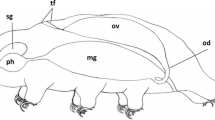Summary
The process of egg segregation in the tunic of the ovoviviparous ascidian Diplosoma listerianum was studied by light and electron microscopy. One egg at a time was seen to mature in each zooid. The eggs had large yolk and grew on the ovary wall enveloped in four layers: (1) outer follicle cells (OFC), long and rich in RER (rough endoplasmic reticulum) and with dense granules in the Golgi region; (2) flat inner follicle cells (IFC); (3) a loosely fibrillar vitelline coat (VC); (4) test cells encased on the egg surface. The growing egg protrudes from the ovary wall and presses on the contiguous epidermis. Granulocytes enter the space between the epidermis and the egg and insinuate cytoplasmic protrusions, disrupting the continuity of the OFC layer. At ovulation, OFC and IFC are discharged and form a post-ovulatory follicle (corpus luteum). The epidermis shrinks and closes, possibly by activation of microfilaments, causing the egg to be completely surrounded by the tunic. In the zooid, the wound caused by the passage of the egg is repaired both by contraction of the epidermis and by phagocytic activity. Altered spermatozoans are found in phagocytosing cells in the lumen of the ovary. These are presumably remnants of those which entered to fertilize the egg before segregation.
Similar content being viewed by others
References
Berrill NJ (1950) The Tunicata, with an account of the British species. Ray Society, London
Brewin BI (1956) The growth and development of a viviparous compound ascidian, Hypsistozoa fasmeriana. Q J Microsc Sci 97:435–454
Brunetti R, Bressan M, Marin M, Libralato M (1988) On the ecology and biology of Diplosoma listerianum (Milne Edwards 1841) (Ascidiacea, Didemnidae). Vie Milieu (in press)
Burighel P, Schiavinato A (1984) Degenerative regression of the digestive tract in the colonial ascidian Botryllus schlosseri (Pallas). Cell Tissue Res 235:309–318
Burighel P, Martinucci GB, Zaniolo G (1986) Ovulation in the ovoviviparous ascidian, Diplosoma listerianum. Acta Embryol Morphol Exp NS 7:102–103
Burighel P, Martinucci GB, Zaniolo G (1987) Tissue repair during egg segregation in tunic of the compound ascidian Diplosoma listerianum. Acta Embryol Morphol Exp NS 8 (in press)
Cloney RA (1978) Ascidian metamorphosis: review and analysis. In: Chia F-S, Rice ME (eds) Settlement and metamorphosis of marine invertebrate larvae. Elsevier North Holland Biomedical Press, New York, pp 255–282
Cotelli F, Andronico F, De Santis R, Monroy A, Rosati F (1981) Differentiation of the vitelline coat in the ascidian Ciona intestinalis: an ultrastructural study. Wilhelm Roux' Arch Dev Biol 190:252–258
De Santis R, Jamunno G, Rosati F (1980) A study of the chorion and follicle cells in relation to sperm-egg interaction in the ascidian, Ciona intestinalis. Dev Biol 74:490–499
Honegger TG (1986) Fertilization in ascidians: studies on the egg envelope, sperm and gamete interactions in Phallusia mammillata. Dev Biol 118:118–128
Kessel RG (1983) Urochordata-Ascidiacea. In: Adiyodi KG, Adiyodi RG (eds) Reproductive biology of invertebrates. Vol I Oogenesis, oviposition and oosorption. Wiley, Chichester New York, pp 655–734
Kott P (1969) Antarctic ascidiacea. Antarctic Res Ser 13:1–239
Lambert CC, Lambert G (1978) Tunicate eggs utilize ammonium ions for flotation. Science 200:64–65
Mackie GO, Singla CL (1987) Impulse propagation and contraction in the tunic of a compound ascidian. Biol Bull 173:188–204
Martinucci GB, Zaniolo G, Burighel P (1986) Ovulazione nelle ascidie coloniali Botryllus schlosseri e Diplosoma listerianum. Boll Zool 53 [Suppl]:22
Monroy A, Rosati F (1983) Review articles: a comparative analysis of sperm-egg interaction. Gam Res 7:85–102
Mukai H (1977) Comparative studies on the structure of reproductive organs of four botryllid ascidians. J Morphol 152:363–379
Mukai H, Saito Y, Watanabe H (1987) Viviparous development in Botrylloides (compound ascidians). J Morphol 193:263–276
Pérès JM (1954) Considérations sur le fonctionnement ovarien chez Ciona intestinalis (L.). Arch Anat Microsc Morphol Exp 43:58–78
Schiaffino S, Burighel P, Nunzi MG (1974) Involution of the caudal musculature during metamorphosis in the ascidian Botryllus schlosseri. Cell Tissue Res 153:293–305
Sugino YM, Tominaga A, Takashima Y (1987) Differentiation of the accessory cells and structural regionalization of the oocyte in the ascidian Ciona savignyi during early oogenesis. J Exp Zool 242:205–214
Van Name WG (1945) The North and South American ascidians. Bull Am Mus Nat Hist 84:1–476
Zaniolo G, Burighel P, Martinucci GB (1987) Ovulation and placentation in Botryllus schlosseri (Ascidiacea): an ultrastructural study. Can J Zool 65:1181–1190
Author information
Authors and Affiliations
Rights and permissions
About this article
Cite this article
Martinucci, G.B., Burighel, P., Zaniolo, G. et al. Ovulation and egg segregation in the tunic of a colonial ascidian, Diplosoma listerianum (Tunicata, Ascidiacea). Zoomorphology 108, 219–227 (1988). https://doi.org/10.1007/BF00312222
Received:
Issue Date:
DOI: https://doi.org/10.1007/BF00312222




